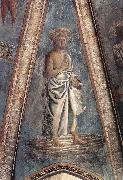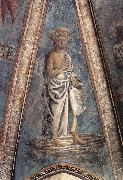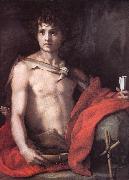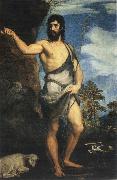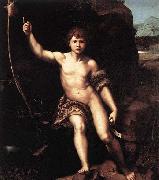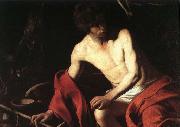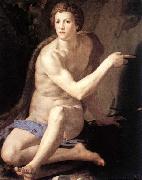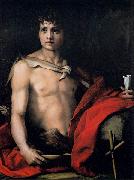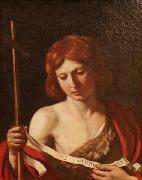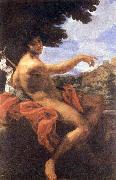Wholesale Oil Painting No Minimum |
|||||||||||
|
|
|||||||||||

|
|||||||||||
|
|
|
||||||||
Andrea del CastagnoItalian c1421-1457 Andrea del Castagno Location Italian c1421-1457 Andrea del Castagno Location Italian painter. He was the most influential 15th-century Florentine master, after Masaccio, of the realistic rendering of the figure and the representation of the human body as a three-dimensional solid by means of contours. By translating into the terms of painting the statues of the Florentine sculptors Nanni di Banco and Donatello, Castagno set Florentine painting on a course dominated by line (the Florentine tradition of disegno), the effect of relief and the sculptural depiction of the figure that became its distinctive trait throughout the Italian Renaissance, a trend that culminated in the art of Michelangelo. |
||||||||
|
|
||||||||
St John the Baptist
St John the Baptist Painting ID:: 4744 |
1442
Fresco
San Zaccaria, Venice 1442 Fresco San Zaccaria, Venice |
|||||||
|
|
||||||||
Fra Filippo LippiItalian 1406-1469 Fra Filippo Lippi Galleries Lippi was born in Florence to Tommaso, a butcher. Both his parents died when he was still a child. Mona Lapaccia, his aunt, took charge of the boy. In 1420 he was registered in the community of the Carmelite friars of the Carmine in Florence, where remained until 1432, taking the Carmelite vows in 1421 when he was sixteen. In his Lives of the Artists, Vasari says: "Instead of studying, he spent all his time scrawling pictures on his own books and those of others," The prior decided to give him the opportunity to learn painting. Eventually Fra Filippo quit the monastery, but it appears he was not released from his vows; in a letter dated 1439 he describes himself as the poorest friar of Florence, charged with the maintenance of six marriageable nieces. In 1452 he was appointed chaplain to the convent of S. Giovannino in Florence, and in 1457 rector (Rettore Commendatario) of S. Quirico in Legania, and made occasional, considerable profits; but his poverty seems chronic, his money being spent, according to one account, in frequent amours. Vasari relates some romantic adventures of Fra Filippo that modern biographers are not inclined to believe. Except through Vasari, nothing is known of his visits to Ancona and Naples, nor of his capture by Barbary pirates and enslavement in Barbary, where his skill in portrait-sketching helped to release him. From 1431 to 1437 his career is not accounted for. Portrait of a Man and Woman at a Casement , c. 1440 Metropolitan Museum of Art, New York City.In June 1456 Fra Filippo is recorded as living in Prato (near Florence) to paint frescoes in the choir of the cathedral. In 1458, while engaged in this work, he set about painting a picture for the convent chapel of S. Margherita of Prato, where he met Lucrezia Buti, the beautiful daughter of a Florentine, Francesco Buti; she was either a novice or a young lady placed under the nuns' guardianship. Lippi asked that she might be permitted to sit for the figure of the Madonna (or perhaps S. Margherita). Under that pretext, Lippi engaged in sexual relations with her, abducted her to his own house, and kept her there despite the nuns' efforts to reclaim her. The result was their son Filippino Lippi, who became a painter no less famous than his father. Such is Vasari's narrative, published less than a century after the alleged events; it is not refuted by saying, more than three centuries later, that perhaps Lippo had nothing to do with any such Lucrezia, and perhaps Lippino was his adopted son, or only an ordinary relative and scholar. The argument that two reputed portraits of Lucrezia in paintings by Lippo are not alike, one as a Madonna in a very fine picture in the Pitti gallery, and the other in the same character in a Nativity in the Louvre, comes to very little; and it is reduced to nothing when the disputant adds that the Louvre painting is probably not done by Lippi at all[clarification needed]. Besides, it appears more likely that not the Madonna in the Louvre but a S. Margaret in a picture now in the Gallery of Prato is the original portrait (according to tradition) of Lucrezia Buti. The frescoes in the choir of Prato cathedral, which depict the stories of St John the Baptist and St Stephen on the two main facing walls, are considered Fra Filippo's most important and monumental works, particularly the figure of Salome dancing, which has clear affinities with later works by Sandro Botticelli, his pupil, and Filippino Lippi, his son, as well as the scene showing the ceremonial mourning over Stephen's corpse. This latter is believed to contain a portrait of the painter, but there are various opinions as to which is the exact figure. On the end wall of the choir are S. Giovanni Gualberto and S. Alberto, while the vault has monumental representations of the four evangelists. The close of Lippi's life was spent at Spoleto, where he had been commissioned to paint, for the apse of the cathedral, scenes from the life of the Virgin. In the semidome of the apse is Christ crowning the Madonna, with angels, sibyls and prophets. This series, which is not wholly equal to the one at Prato, was completed by Fra Diamante after Lippi's death. That Lippi died in Spoleto, on or about the 8th of October 1469, is a fact; the mode of his death is a matter of dispute. It has been said that the pope granted Lippi a dispensation for marrying Lucrezia, but before the permission arrived, Lippi had been poisoned by the indignant relatives of either Lucrezia herself or some lady who had replaced her in the inconstant painter's affections. This is now generally regarded as a fable, and indeed, a vendetta upon a man aged sixty-three for a seduction committed at the age of fifty-two seems hardly plausible. Fra Filippo lies buried in Spoleto, with a monument erected to him by Lorenzo the Magnificent; he had always been zealously patronized by the Medici family, beginning with Cosimo de Medici. Francesco di Pesello (called Pesellino) and Sandro Botticelli were among his most distinguished pupils. The altarpiece Lippi painted in 1441 for the nuns of S. Ambrogio is now a prominent attraction in the Academy of Florence, and was celebrated in Browning's well-known poem. It represents the coronation of the Virgin among angels and saints, including many Bernardine monks. One of these, placed to the right, is a half-length portrait of Lippo, pointed out by the inscription perfecit opus upon an angel's scroll. The price paid for this work in 1447 was 1200 Florentine lire, which seems surprisingly large. Selfportait with pupilsFor Germiniano Inghirami of Prato he painted the Death of St. Bernard. His principal altarpiece in this city is a Nativity in the refectory of S. Domenico ?? the Infant on the ground adored by the Virgin and Joseph, between Saints George and Dominic, in a rocky landscape, with the shepherds playing and six angels in the sky. In the Uffizi is a fine Virgin adoring the infant Christ, who is held by two angels; in the National Gallery, London, a Vision of St Bernard. The picture of the Virgin and Infant with an Angel, in this same gallery, also ascribed to Lippi, is disputable. Filippo Lippi died in 1469 while working on the frescos Storie della Vergine (Scenes of the life of the Virgin Mary, 1467 - 1469) in the apse of the Spoleto Cathedral. The Frescos show the Annunciation, the Funeral, the Adoration of the Child and the Coronation of the Virgin. A group of bystanders at the Funeral includes a self-portrait of Lippi together with his son Fillipino and his helpers Fra Diamante and Pier Matteo d'Amelia. Lippi was buried on the right side of the transept. The frescos were completed by Filippino Lippi, who also designed the funerary monument for his father. Although it was commissioned by Lorenzo de Medici it was not actually made until 1490 by an unknown Florentine sculptor. |
||||||||
|
|
||||||||
|
|
St John the Baptist
St John the Baptist Painting ID:: 32134 |
mk78
Florence,
Uffizi
mk78 Florence, Uffizi |
||||||
|
|
||||||||
Andrea del CastagnoItalian c1421-1457 Andrea del Castagno Location Italian c1421-1457 Andrea del Castagno Location Italian painter. He was the most influential 15th-century Florentine master, after Masaccio, of the realistic rendering of the figure and the representation of the human body as a three-dimensional solid by means of contours. By translating into the terms of painting the statues of the Florentine sculptors Nanni di Banco and Donatello, Castagno set Florentine painting on a course dominated by line (the Florentine tradition of disegno), the effect of relief and the sculptural depiction of the figure that became its distinctive trait throughout the Italian Renaissance, a trend that culminated in the art of Michelangelo. |
||||||||
|
|
||||||||
|
|
St John the Baptist
St John the Baptist Painting ID:: 32202 |
1442
Fresco 1442 Fresco |
||||||
|
|
||||||||
Andrea del Sartob.July 16, 1486, Florence d.Sept. 28, 1530, Florence Italian Andrea del Sarto Galleries Andrea del Sarto (1486 ?C 1531) was an Italian painter from Florence, whose career flourished during the High Renaissance and early-Mannerism. Though highly regarded by his contemporaries as an artist "senza errori" (i.e., faultless), he is overshadowed now by equally talented contemporaries like Raphael. Andrea fell in love with Lucrezia (del Fede), wife of a hatter named Carlo, of Recanati; the hatter dying opportunely, Andrea married her on 26 December 1512. She has come down to us in many a picture of her lover-husband, who constantly painted her as a Madonna and otherwise; even in painting other women he made them resemble Lucrezia. She was less gently handled by Giorgio Vasari, a pupil of Andrea, who describes her as faithless, jealous, and vixenish with the apprentices; her offstage character permeates Robert Browning's poem-monologue "Andrea del Sarto called the 'faultless painter'" (1855) . He dwelt in Florence throughout the memorable siege of 1529, which was soon followed by an infectious pestilence. He caught the malady, struggled against it with little or no tending from his wife, who held aloof, and he died, no one knowing much about it at the moment, on 22 January 1531, at the comparatively early age of forty-three. He was buried unceremoniously in the church of the Servites. His wife survived her husband by forty years. A number of paintings are considered to be self-portraits. One is in the National Gallery, London, an admirable half-figure, purchased in 1862. Another is at Alnwick Castle, a young man about twenty years, with his elbow on a table. Another youthful portrait is in the Uffizi Gallery, and the Pitti Palace contains more than one. |
||||||||
|
|
||||||||
|
|
St John the Baptist
St John the Baptist Painting ID:: 32229 |
1528
Oil on wood, 94 x 68 cm 1528 Oil on wood, 94 x 68 cm |
||||||
|
|
||||||||
TitianItalian High Renaissance Painter, ca.1485-1576 Italian painter active in Venice. As a young man he was taught by the Bellini family and worked closely with Giorgione. His early works are so similar in style to Giorgione's as to be indistinguishable, but soon after Giorgione's early death Titian established himself as the leading painter of the Republic of Venice. Among his most important religious paintings is the revolutionary and monumental Assumption (1516 ?C 18) for Santa Maria dei Frari, in which the Virgin ascends to heaven in a blaze of colour accompanied by a semicircle of angels. Titian was also interested in mythological themes, and his many depictions of Venus display his work's sheer beauty and inherent eroticism. Bacchus and Ariadne (1520 ?C 23), with its pagan abandon, is one of the greatest works of Renaissance art. Titian was sought after for his psychologically penetrating portraits, which include portrayals of leading Italian aristocrats, religious figures, and Emperor Charles V. He reached the height of his powers in The Rape of Europa (c. 1559 ?C 62), one of several paintings done for Philip II of Spain. He was recognized as supremely gifted in his lifetime, and his reputation has never declined. |
||||||||
|
|
||||||||
|
|
St John the Baptist
St John the Baptist Painting ID:: 41169 |
mk157
c.1540
Oil on canvas
201x134cm
mk157 c.1540 Oil on canvas 201x134cm |
||||||
|
|
||||||||
RAFFAELLO SanzioItalian High Renaissance Painter, 1483-1520 Italian painter and architect. As a member of Perugino's workshop, he established his mastery by 17 and began receiving important commissions. In 1504 he moved to Florence, where he executed many of his famous Madonnas; his unity of composition and suppression of inessentials is evident in The Madonna of the Goldfinch (c. 1506). Though influenced by Leonardo da Vinci's chiaroscuro and sfumato, his figure types were his own creation, with round, gentle faces that reveal human sentiments raised to a sublime serenity. In 1508 he was summoned to Rome to decorate a suite of papal chambers in the Vatican. The frescoes in the Stanza della Segnatura are probably his greatest work; the most famous, The School of Athens (1510 C 11), is a complex and magnificently ordered allegory of secular knowledge showing Greek philosophers in an architectural setting. The Madonnas he painted in Rome show him turning away from his earlier work's serenity to emphasize movement and grandeur, partly under Michelangelo's High Renaissance influence. The Sistine Madonna (1513) shows the richness of colour and new boldness of compositional invention typical of his Roman period. He became the most important portraitist in Rome, designed 10 large tapestries to hang in the Sistine Chapel, designed a church and a chapel, assumed the direction of work on St. Peter's Basilica at the death of Donato Bramante, |
||||||||
|
|
||||||||
|
|
St John the Baptist
St John the Baptist Painting ID:: 51263 |
c. 1518
Oil on canvas,
165 x 147 cm c. 1518 Oil on canvas, 165 x 147 cm |
||||||
|
|
||||||||
El GrecoGreek-born Spanish Mannerist Painter, 1541-1614 Considered a representative of late Renaissance Spanish art, El Greco was actually born in Greece, on the island of Crete. After studying in Venice under Titian, El Greco settled in Toledo, Spain in 1577. At the time he was wildly popular, his emotionally religious paintings being just the ticket for the hometown of the Spanish Inquisition. After his death his work was largely ignored until the beginning of the 20th century; now he considered one of the inspired geniuses of Western art. His distinctive style features bold shapes and colors, with elongated and slightly distorted figures. In Toledo El Greco was in constant demand and liked living large: he maintained a private orchestra to accompany his meals. |
||||||||
|
|
||||||||
|
|
St John the Baptist
St John the Baptist Painting ID:: 53570 |
mk233
1577-1579
Oil on canvas
232x78cm
mk233 1577-1579 Oil on canvas 232x78cm |
||||||
|
|
||||||||
CaravaggioItalian Baroque Era Painter, ca.1571-1610 Italian painter. After an early career as a painter of portraits, still-life and genre scenes he became the most persuasive religious painter of his time. His bold, naturalistic style, which emphasized the common humanity of the apostles and martyrs, flattered the aspirations of the Counter-Reformation Church, while his vivid chiaroscuro enhanced both three-dimensionality and drama, as well as evoking the mystery of the faith. He followed a militantly realist agenda, rejecting both Mannerism and the classicizing naturalism of his main rival, Annibale Carracci. In the first 30 years of the 17th century his naturalistic ambitions and revolutionary artistic procedures attracted a large following from all over Europe. |
||||||||
|
|
||||||||
|
|
St John the Baptist
St John the Baptist Painting ID:: 62375 |
94 x 131 cm Galleria Nazionale d'Arte Antica, Rome In around 1605 Caravaggio dealt with St. John the Baptist in two splendid compositions, one in the Kansas City Gallery, the other in the Galleria Nazionale di Arte Antica in Rome. The former is laid out vertically, the latter horizontally. Both lend themselves to a modernistic reading aimed at pointing out a certain air between contempt and arrogance. In effect what we are dealing with here are splendid exercises in modeling the body through the play of light and shadow. In the version now in Kansas City, the figure is set before a dense curtain of plants; in that in Rome, there is only the trunk of a cypress tree, on the left. Both are admirable feats of painting, and it is understandable that collectors competed with each other for the artist's works. Caravaggio in turn knew how to make apparently uninteresting religious themes into paintings desirable even for his aristocratic patrons. 94 x 131 cm Galleria Nazionale d'Arte Antica, Rome In around 1605 Caravaggio dealt with St. John the Baptist in two splendid compositions, one in the Kansas City Gallery, the other in the Galleria Nazionale di Arte Antica in Rome. The former is laid out vertically, the latter horizontally. Both lend themselves to a modernistic reading aimed at pointing out a certain air between contempt and arrogance. In effect what we are dealing with here are splendid exercises in modeling the body through the play of light and shadow. In the version now in Kansas City, the figure is set before a dense curtain of plants; in that in Rome, there is only the trunk of a cypress tree, on the left. Both are admirable feats of painting, and it is understandable that collectors competed with each other for the artist's works. Caravaggio in turn knew how to make apparently uninteresting religious themes into paintings desirable even for his aristocratic patrons. |
||||||
|
|
||||||||
Agnolo BronzinoItalian Mannerist Painter, 1503-1572 Agnolo di Cosimo (November 17, 1503 ?C November 23,1572), usually known as Il Bronzino, or Agnolo Bronzino (mistaken attempts also have been made in the past to assert his name was Agnolo Tori and even Angelo (Agnolo) Allori), was an Italian Mannerist painter from Florence. The origin of his nickname, Bronzino is unknown, but could derive from his dark complexion, or from that he gave many of his portrait subjects. It has been claimed by some that he had dark skin as a symptom of Addison disease, a condition which affects the adrenal glands and often causes excessive pigmentation of the skin. |
||||||||
|
|
||||||||
|
|
St John the Baptist
St John the Baptist Painting ID:: 63530 |
1550-55 Oil on wood, 120 x 92 cm Galleria Borghese, Rome Appearing to be full-size, this painting demonstrates the skill of the Mannerist painter in fitting a brilliant body-study into a small pictorial space. Artistically, all interest is on the nude, with the nakedness concealed more by the way the figure holds his body than the way he plays with the drapery and the hide mantle. The only symbol in the picture is the Jacob's staff, in the dark. This is cleverly foreshortened, and thus not the real message of the painting.Artist:BRONZINO, Agnolo Title: St John the Baptist Painted in 1501-1550 , Italian - - painting : religious 1550-55 Oil on wood, 120 x 92 cm Galleria Borghese, Rome Appearing to be full-size, this painting demonstrates the skill of the Mannerist painter in fitting a brilliant body-study into a small pictorial space. Artistically, all interest is on the nude, with the nakedness concealed more by the way the figure holds his body than the way he plays with the drapery and the hide mantle. The only symbol in the picture is the Jacob's staff, in the dark. This is cleverly foreshortened, and thus not the real message of the painting.Artist:BRONZINO, Agnolo Title: St John the Baptist Painted in 1501-1550 , Italian - - painting : religious |
||||||
|
|
||||||||
Andrea del Sartob.July 16, 1486, Florence d.Sept. 28, 1530, Florence Italian Andrea del Sarto Galleries Andrea del Sarto (1486 ?C 1531) was an Italian painter from Florence, whose career flourished during the High Renaissance and early-Mannerism. Though highly regarded by his contemporaries as an artist "senza errori" (i.e., faultless), he is overshadowed now by equally talented contemporaries like Raphael. Andrea fell in love with Lucrezia (del Fede), wife of a hatter named Carlo, of Recanati; the hatter dying opportunely, Andrea married her on 26 December 1512. She has come down to us in many a picture of her lover-husband, who constantly painted her as a Madonna and otherwise; even in painting other women he made them resemble Lucrezia. She was less gently handled by Giorgio Vasari, a pupil of Andrea, who describes her as faithless, jealous, and vixenish with the apprentices; her offstage character permeates Robert Browning's poem-monologue "Andrea del Sarto called the 'faultless painter'" (1855) . He dwelt in Florence throughout the memorable siege of 1529, which was soon followed by an infectious pestilence. He caught the malady, struggled against it with little or no tending from his wife, who held aloof, and he died, no one knowing much about it at the moment, on 22 January 1531, at the comparatively early age of forty-three. He was buried unceremoniously in the church of the Servites. His wife survived her husband by forty years. A number of paintings are considered to be self-portraits. One is in the National Gallery, London, an admirable half-figure, purchased in 1862. Another is at Alnwick Castle, a young man about twenty years, with his elbow on a table. Another youthful portrait is in the Uffizi Gallery, and the Pitti Palace contains more than one. |
||||||||
|
|
||||||||
|
|
St John the Baptist
St John the Baptist Painting ID:: 77025 |
Date ca. 1523(1523)
Medium Oil on wood
cyf Date ca. 1523(1523) Medium Oil on wood cyf |
||||||
|
|
||||||||
GUERCINOItalian Baroque Era Painter, 1591-1666 best known as Guercino or Il Guercino, was an Italian Baroque painter from the region of Emilia, and active in Rome and Bologna. Guercino is Italian for squinter, a nickname that was given to him because he was cross-eyed. He is especially noted for his many superb drawings. Guercino was born at Cento, a village between Bologna and Ferrara. By the age of 17 he was associated with Benedetto Gennari, a painter of the Bolognese School. By 1615 he moved to Bologna, where his work earned the praise of an elder Ludovico Carracci. He painted two large canvases, Elijah Fed by Ravens and Samson Seized by Philistines, in what appears to be a stark naturalist Caravaggesque style (although it is unlikely he had been able to see any of the Roman Caravaggios first-hand). They were painted for Cardinal Serra, Papal Legate to Ferrara. The Arcadian Shepherds (Et in Arcadia ego) was painted in 1618 contemporary with The Flaying of Marsyas by Apollo in Palazzo Pitti. His first style, he often claimed, was influenced by a canvas of Carracci in Cento. Some of his later pieces approach rather to the manner of his great contemporary Guido Reni, and are painted with more lightness and clearness. Guercino was esteemed very highly in his lifetime. He was then recommended by Marchese Enzo Bentivoglio to the Bolognese Ludovisi Pope, Pope Gregory XV. His two years (1621-23) spent in Rome were very productive. From this stay date his frescoes of Aurora at the casino of the Villa Ludovisi and the ceiling in San Crisogono (1622) of San Chrysogonus in Glory; his portrait of Pope Gregory (now in the Getty Museum, and, what is considered his masterpiece, The Burial of Saint Petronilla or St. Petronilla Altarpiece, for the Vatican (now in the Museo Capitolini). The Franciscan order of Reggio in 1655 paid him 300 ducats for the altarpiece of Saint Luke Displaying a Painting of the Madonna and Child (now in Nelson-Atkins Museum of Art, Kansas City). The Corsini also paid him 300 ducats for the Flagellation of Christ painted in 1657. |
||||||||
|
|
||||||||
|
|
St John the Baptist
St John the Baptist Painting ID:: 84355 |
ca. 1645(1645)
Medium Oil on canvas
cyf ca. 1645(1645) Medium Oil on canvas cyf |
||||||
|
|
||||||||
Fra CarnevaleItalian, active 1445-1484 |
||||||||
|
|
||||||||
|
|
St John the Baptist
St John the Baptist Painting ID:: 86511 |
Date 1450s
Medium tempera and Oil on wood
Dimensions Height: 80 cm (31.5 in). Width: 44 cm (17.3 in).
cjr Date 1450s Medium tempera and Oil on wood Dimensions Height: 80 cm (31.5 in). Width: 44 cm (17.3 in). cjr |
||||||
|
|
||||||||
Jan Van Eyck1395-1441 Flemish Jan Van Eyck Locations Painter and illuminator, brother of Hubert van Eyck. According to a 16th-century Ghent tradition, represented by van Vaernewijck and Lucas d Heere, Jan trained with his brother Hubert. Pietro Summonte assertion (1524) that he began work as an illuminator is supported by the fine technique and small scale of most of Jan works, by manuscript precedents for certain of his motifs, and by his payment in 1439 for initials in a book (untraced) for Philip the Good, Duke of Burgundy. Jan is first documented in The Hague in August 1422 as an established artist with an assistant and the title of Master, working for John III, Count of Holland (John of Bavaria; reg 1419-25), who evidently discovered the artist while he was bishop (1389-1417) of the principality of Liege. Jan became the court official painter and was paid, with a second assistant when the work increased in 1423, continuously, probably until the count death in January 1425. |
||||||||
|
|
||||||||
|
|
St John the Baptist
St John the Baptist Painting ID:: 93753 |
between 1425(1425) and 1429(1429)
Medium oil on panel
Dimensions Height: 168.1 cm (66.2 in). Width: 75.1 cm (29.6 in).
cjr between 1425(1425) and 1429(1429) Medium oil on panel Dimensions Height: 168.1 cm (66.2 in). Width: 75.1 cm (29.6 in). cjr |
||||||
|
|
||||||||
Bernardo Strozzi1581-1644 Italian Bernardo Strozzi Galleries Strozzi was born in Genoa. He was probably not related to the other Strozzi family. In 1598, at the age of 17, he joined a Capuchin monastery, a reform branch of the Franciscan order. When his father died c1608, he left the order to care for his mother, earning their living with his paintings, which were often influenced by Franciscan teachings, for example his Adoration of the Shepherds (c. 1615) . In 1625, he was charged with illegally practicing as a painter. When his mother died c1630, Bernardo was pressured in court by the Capuchin's to re-enter the order. He was briefly imprisoned in Genoa , and upon release fled to Venice to avoid confinement in a monastery in 1631. He became nicknamed all his life as il prete Genovese (the Genoa priest). Saint Christopher, by Strozzi.Early paintings, such as The Ecstasy of St Francis show the dark emotionalism of Caravaggio. But by the second decade of the 17th century, while working in Venice, Strozzi had synthesized a personal style which fused painterly influences of the North (including Rubens and Veronese) with a monumental realistic starkness. For example, in the painting The Incredulity of Thomas, the background is muted, yet Jesus' face, haloed and his outline, misty, in a style atypical of Caravaggio. Never as dark as the Caravaggisti, Venice infused his painting with a gentler edge, a style more acceptable to the local patronage, and one derived from his precursors in Venice, Jan Lys (died 1629) and Domenico Fetti (died 1626), who had also fused the influence of Caravaggio into Venetian art. Examples of this style can be found in his Parable of the Wedding Guests (1630),Christ giving keys of Heaven to Saint Peter (1630),, Saint Lawrence distributing Alms at San Nicol?? da Tolentino[7] and a Personification of Fame (1635-6). He was also likely influenced by Velazquez (who visited Genoa in 1629-30). After a commission to paint Claudio Monteverdi his fame grew, and his portrait paintings included many of the leading Venetians. His pupils and painter strongly influenced by him included Giovanni Andrea de Ferrari (1598-1669), Giovanni Bernardo Carbone, Valerio Castello and, Giovanni Benedetto Castiglione. |
||||||||
|
|
||||||||
|
|
St John the Baptist
St John the Baptist Painting ID:: 95761 |
between 1615(1615) and 1620(1620)
Medium oil on canvas
cyf between 1615(1615) and 1620(1620) Medium oil on canvas cyf |
||||||
|
|
||||||||
Giovanni Battista Gaulli Called BaccicioGenoa 1639-Rome 1709 |
||||||||
|
|
||||||||
|
|
St John the Baptist
St John the Baptist Painting ID:: 95950 |
circa 1676(1676)
Medium oil on canvas
cyf circa 1676(1676) Medium oil on canvas cyf |
||||||
|
|
||||||||
|
Giovanni Battista Gaulli Called Baccicio Genoa 1639-Rome 1709 St John the Baptist circa 1676(1676) Medium oil on canvas cyf |
||||||||
|
|
||||||||
|
Prev Next
|
||||||||
|
|
||||||||
|
Related Paintings to Giovanni Battista Gaulli Called Baccicio :. |
||||||||
|
|
||||||||
|
CONTACT US |
